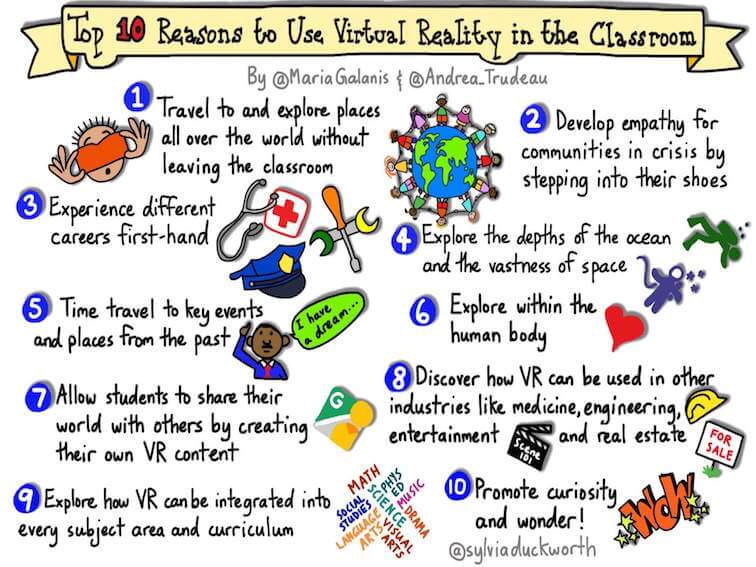
Why You Should Use Virtual Reality In The Classroom
by TeachThought Staff
Although still an emerging technology in terms of recognizing its full potential, virtual reality offers the opportunity to step into places, roles, and experiences that were previously impossible, or at the very least, inaccessible to most.
As Terry Heick said in Why Virtual Reality is So Important, “Through the use of digital technology, virtual realities can be designed precisely for human interaction for very specific reasons to create experiences not otherwise possible.
By suspending disbelief the same way we do when we read a novel or watch a movie, an artificial reality can be designed to enable experiential learning, scenario-based learning, social learning, workplace training, and more. Virtual reality can be used for pure entertainment–digital toys, video games, or to swim with whales.”
Sylvia Duckworth, sketchnoter extraordinaire, put together a graphic of ideas from Maria Galanis and Andrea Trudeau on Top 10 Reasons To Use Virtual Reality In The Classroom to help bring the world (and beyond) to your students with technology.
10 Reasons To Use Virtual Reality In The Classroom
1. Travel to and explore places all over the world without leaving the classroom.
Virtual reality makes travel possible without the constraints of time and permission slips. Visit the Taj Mahal with a virtual class tour or tour an art museum without stepping foot on a bus.
2. Develop empathy for communities in crisis by stepping into their shoes.
Bring the concept of empathy to life by giving students additional context with the sights and sounds of a setting or experience. (See 30 Of the Best Books To Teach Children Empathy for additional inspiration)
3. Experience different careers first-hand.
Students can see life through the eyes of a surgeon, museum curator, soldier, or other professional fields for a better picture of what life in that role would look like.
4. Explore the depths of the ocean and the vastness of space.
Children have a natural love for adventure, and the immensity of the ocean and space, and all both have to offer allows students to satisfy that curiosity without the need for a submarine or rocket ship.
5. Time travel to key events and places from the past.
Imagine being present at Martin Luther King’s “I Have A Dream Speech” or accompanying Neil Armstrong on the first moonwalk — it would be a lot more memorable than reading about it, right?
6. Explore the human body.
Anatomy takes on a new dimension of understanding when you can see organs, muscles, and skeletal structures in place and functioning; even dissections have gone digital.
7. Allow students to share their world with others by creating their own VR content.
Engage students creatively by encouraging them to create their own three-dimensional experience to showcase their imagination.
8. Discover how VR can be used in other industries like medicine, engineering, entertainment, and real estate.
Research how virtual reality is used as a tool in some industries to help students develop an understanding of the technology and its future in business.
9. Explore how VR can be integrated into every subject area and curriculum.
Due to the fact that it’s relatively new in terms of accessibility, there’s untold potential in using virtual reality as an educational conduit, making it an exciting option for teachers and students alike.
10. Promote curiosity and wonder.
“Like the caffeine in coffee, the chords on a guitar, or the wet in water, genuine curiosity is not a thing, it’s the thing. Not temporarily wanting to know, or being vaguely interested in an answer, but being able to put together past experience and knowledge like the millions of fibers on a network,” Terry Heick said in 5 Learning Strategies That Make Students Curious.
The immersive nature of virtual reality brings depth to educational content by engaging the senses and allowing exploration to a degree that would be difficult to duplicate within the confines of a classroom, making it an ideal catalyst for curiosity and true learning.
10 Reasons To Use Virtual Reality In The Classroom
